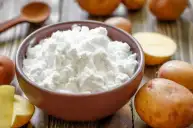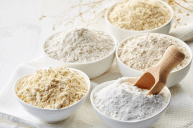How many coffee beans do you use each day? It's probably not something you really think about, but 12 ounces of coffee has about 180 beans. Multiply that by the number of people who drink 12 ounces of coffee every day and that's a lot of beans. A coffee bean isn't just the bean, though. There's a whole part of the coffee plant that gets tossed out and that's where the story of coffee flour starts.
Once the coffee is harvested, the coffee cherry is split into two parts. The bean goes on to glory in your coffee cup, while the fruit pulp that surrounded the bean is left to rot or, too frequently, dumped into rivers where it pollutes the waters with ochratoxins, aflatoxins, and caffeine. The more coffee is grown, the more waste produced. Some farmers use the pulp as compost, but we're talking a lot of coffee, so there's generally more waste than a local need for compost.
Enter coffee flour.
In a triumph of sustainability, the once-discarded outer part of the coffee fruit is dried and then ground into a "flour." It's genuinely a no-waste food with a positive impact on the environment because it's turning what was waste into a useful commodity.
But the sustainability factor isn't the only reason coffee flour is a superfood; it's also a "superfood." Coffee flour has more iron than fresh spinach, more protein than fresh kale, and more potassium than a banana. Plus, it's high in antioxidants and has more fiber than in whole wheat flour, and it's low in fat (it contains less fat per gram than coconut flour). And it's paleo friendly and a gluten-free flour.
If that weren't enough, coffee flour also has the potential to better the lives of coffee farmers. The price of coffee (as a commodity like wheat and corn and rice) fluctuates, depending on the market. But if farmers can use the entire coffee bean, that extra revenue source may create a more stable income for them. And, of course, there are the additional jobs created to make and package the coffee flour.
Sustainable, high nutritional value, and potentially an economic game-changer for the coffee industry: coffee flour seems to have it all. But how does it taste? According to some of our favorite foodies, it tastes great and adds a deep flavor to baked goods that cooks compare to figs. It doesn't taste like coffee, though there are a lot of recipe suggestions for adding to chocolate cake and cookies to get the perfect coffee/chocolate combo. It does have a tiny bit of caffeine, about the same amount as that in dark chocolate.
Coffee flour is still considered a specialty item, though it's becoming popular with celebrity chefs and food companies (even Trader Joe's has a brand of coffee flour, although it doesn't look like it's in stock right now). Right now, Coffee Flour, the company that started it all, is working in Nicaragua, Guatemala, Mexico, Papua New Guinea, and Vietnam. They hope to keep expanding to other coffee producing countries around the world. You can check the Coffee Flour website for places to buy (online may be your best bet).




